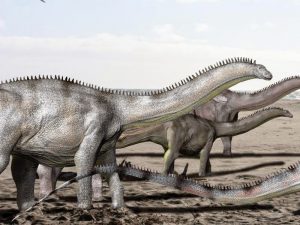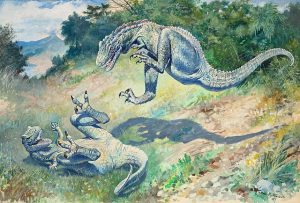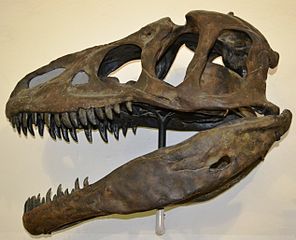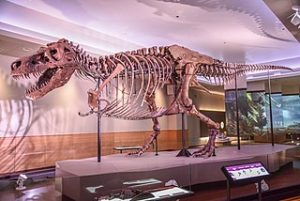
Dinosaurs were ancient reptiles that were the most successful land animals for 165 million years. They came in many shapes and sizes, with species taking the forms of swift runners, such as the Velociraptor; long-necked plant eaters, such as the Brontosaurus, and the mighty Tyrannosaurus Rex. Though most dinosaurs went extinct sometime after a massive meteor hit Earth 65 million years ago, one lineage survived in the form of birds, and we can still find the bones of long-dead dinosaurs buried within the earth. Scientists are discovering new species even to this year, and our knowledge of these creatures continues to expand. After you learn about the history of paleontology and how scientists find the bones of dinosaurs, you may want to try to discover a new dinosaur yourself someday.
Educational, easy-to-understand books about dinosaurs and paleontology.
Detailed drawings and information about dinosaurs and other prehistoric life.
Explains the nature of dinosaur eggs, using recently discovered egg fossils from Patagonia.
A "living history" of the early Cretaceous period. Details the environment and ecosystem as if it were a place you could still visit. Explains each dinosaur's specific role in the environment and how they interacted.
A Brief History of the Dinosaurs
The Mesozoic, the Age of the Dinosaurs, lasted about 180 million years, from about 251 million years ago to about 66 million years ago. It is divided into three time periods, the Triassic, Jurassic, and Cretaceous, and dinosaurs originated in the earliest of these, the Triassic. In the Triassic, all the world’s continents were together as a single land mass, Pangaea, and much of the land was covered in deserts. Because the environment was so hostile and food could be scarce, many dinosaurs of this time were quite small, like the Coelophysis. It would take the breakup of Pangaea and a massive extinction event at the end of the Triassic to clear the way for the larger dinosaurs to emerge.
During the Jurassic, dinosaurs grew to massive sizes and evolved into many specialized forms. This was the time that the sauropods, enormous browsers of the tree tops, first emerged. They began to grow to massive size early in their appearance in the fossil record and continually grew larger throughout the Jurassic as species such as Brachiosaurus and Diplodocus emerged. Although sauropods were perhaps the most memorable dinosaurs of the Jurassic, other distinct groups began to emerge during this period as well. The plated, spike-tailed stegosaurs also appeared, eating plants close to the ground as the sauropods grazed the high branches. Though stegosaurs were still quite large by the standards of modern animals, they were much smaller than the sauropods. They had to rely on their spikes to ward off attacks from the meat-eating carnosaurs, such as the Allosaurus, and ceratosaurs, such as the Ceratosaurus that often hunted them.
The Cretaceous was the last and longest of the three periods of the Mesozoic. Two very important things happened over the course of this period that altered the evolution of the dinosaurs. The first was the evolution of flowering plants, which became widespread and greatly reduced the abundance of earlier plants, such as cycads. Dinosaurs that depended on these older forms of plants for their food, such as stegosaurs, went extinct as the vegetation changed. New groups of plant eaters, including “duck-billed” dinosaurs, such as Edmontosaurus, opens a new window; and horned ceratopsians, such as Styracosaurus; evolved to eat the new and abundant flowering plants. The second evolution-altering event was the further break-up of Pangaea into continents shaped more like those of today. Following the break-up, the world’s landscape became dominated by wetlands and warm, shallow seas. As the new plants flourished in the coastal wetlands, great herds of duckbills and ceratopsians grazed together, and the surviving sauropods, such as Dreadnoughtus, became the largest land animals that ever lived. But the herbivores of the Cretaceous still had dangerous enemies lurking, as the tyrannosaurs rose to prominence and great size, finally evolving into Tyrannosaurus Rex before the meteor descended that is believed to have ended the age of the dinosaurs.
Treasures in the Rocks: The Development of Paleontology
Paleontology is the science of studying the fossilized remains of ancient animals and plants. Although the fossils themselves are millions of years old, the science of paleontology is a relatively recent one, only dating back to the early 19th century. One of the earliest paleontologists was Georges Cuvier, the first scientist who determined that animals could go extinct over time. He was also one of the first scientists to identify a flying reptile from the dinosaur age, which he named Pterodactyl. Cuvier named the Pterodactyl in 1809, but the discovery and establishment of the dinosaurs themselves would have to wait until 1822, when Mary Ann and Gideon Mantel discovered gigantic fossilized teeth. Gideon later determined that they most resembled the teeth of an iguana, only much larger, so he named the creature Iguanodon (Iguana-Tooth).
At around the same time as Iguanodon, another dinosaur was discovered. William Buckland, the first professor of geology at Oxford University, identified a series of previously unidentified bones as coming from a single animal, naming it Megalosaurus, or “Great Lizard”. These two genera would be combined with a third, Hyleaosaurus, to form the basic classification of Dinosauria by Richard Owen in 1842. Interest in dinosaurs among the public was immediate, but the early fossils were very incomplete, and scientists had great difficulty reconstructing them. Early models like the “Crystal Palace Dinosaurs” looked like giant lizards, with a Megalosaurus that looked like a komodo dragon and an Iguanodon that resembled an iguana with a nose horn.

Many of the early dinosaur discoveries happened in Europe and the United Kingdom. Paleontology would come to the United States in the 1870s, as westward expansion and exploration of the land drove the search for new fossils. Paleontologists Edward Cope and Othniel Charles Marsh entered into a dramatic rivalry, each seeking to name and classify as many fossils as they could in a rush for personal glory and career success. Their rivalry began in 1868, when Marsh bribed the pit operators in a dig for Hadrosaurus fossils in New Jersey to give future finds to him rather than Cope. Their relationship only got worse as with time as Cope headed west with the U.S. Geological Survey in 1872. Cope and Marsh fought each other viciously in the public eye, slandering each other in newspapers and scientific journals, even as they discovered and identified dozens of dinosaurs like Triceratops, Brontosaurus, and Ceratosaurus. Neither man won the “Bone Wars;” both Cope and Marsh spent their personal fortunes in pursuit of science and died poor men. But our understanding of dinosaurs and other prehistoric animals was made much richer by the days of their feud.
New Age of Discovery: Fossil Finds of Modern Times
Paleontologists are continuing to discover new fossils in the early decades of the 21st century. The number of animals that died and had their bones fossilized is quite low, but there are other ways to discover the presence of dinosaurs in the rocks. Footprints of dinosaurs have been found in many places where the bones did not fossilize, including the Fredericksburg area. Footprints of multiple dinosaurs have been discovered on land in Spotsylvania and Stafford, including the gigantic Sauroposeidon. The largest collection of dinosaur footprints in Virginia can be found in Culpeper at the Luck Stone quarry. There, you can see an extensive array of Triassic era footprints at the annual Dino Walk. Footprints have even been used to determine the existence of dinosaur species with no existing bones. Because of footprints alone, we know the existence of many large dinosaurs in Australia, including a meat eater as large as Tyrannosaurus.
Finding new fossils of dinosaurs that were already discovered is just as important for science as finding new footprints. Finding a complete skeleton, although extremely rare, is a dramatic leap in understanding a dinosaur species. Tyrannosaurus is one of the best known dinosaurs thanks to “Sue,” a 1990 discovery that allowed scientists to understand everything from T-Rex’s growth rate to how much the arms could move. Studying Sue’s bones for age and growth rate allowed scientists to model the phases of a T-Rex’s life and proved that the supposed separate species “Nanotyrannus” was simply a juvenile T-Rex.
Unearthing a new part of an incomplete dinosaur skeleton is more typical than a complete skeleton discovery, but these can also mark a major step in scientific understanding. The 50-foot-long Spinosaurus was long portrayed as a land animal, and made famous as the “T-Rex killer” in Jurassic Park III. But the fossil remains of Spinosaurus were very incomplete, and scientists couldn’t tell how it moved or where it lived in the environment. Some scientists thought that Spinosaurus swam through the rivers and seashores eating fish, but others thought that it lived and hunted on land like Tyrannosaurus. The debate finally ended in 2020 with the discovery of some Spinosaurus tail bones, opens a new window, which were shaped much like those of a crocodile. It turned out that the largest predatory dinosaur was also the first swimming one—a real Godzilla!
New dinosaur species have been discovered even in recent decades. In 1993, the year Jurassic Park, opens a new window was released in theaters, a giant predator of a size to rival Tyrannosaurus Rex was discovered in Argentina, opens a new window. Giganotosaurus, opens a new window, the "giant southern lizard," was a massive carnivore that lived about 98 million years ago. It was so large that it might have been slightly longer and taller (due to the bones on its spine) than T-Rex, but was believed to have weighed somewhat less. Giganotosaurus was the largest predator of its ecosystem and would have likely eaten juvenile sauropods, such as the massive Andesaurus, opens a new window. The known fossils of Giganotosaurus are very fragmentary, so much remains to be learned about this creature. We do know that it would never have encountered Tyrannosaurus in real life—it lived 30 million years before T-Rex and in a place far from the Rex's Hell Creek, opens a new window stomping grounds.
New discoveries are being made about dinosaurs every year. As paleontologists further explore the rocks and sediment of the world, new footprints, bones, and even dinosaur eggs are being discovered. We can only imagine what wonderful finds await us in the next decade. Perhaps, as with the footprints in Spotsylvania and Stafford, the next big discovery may happen very close to home.




